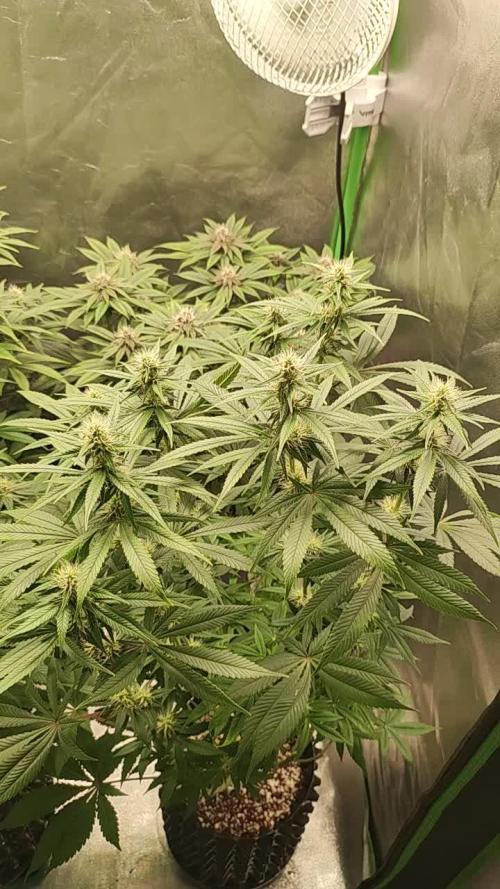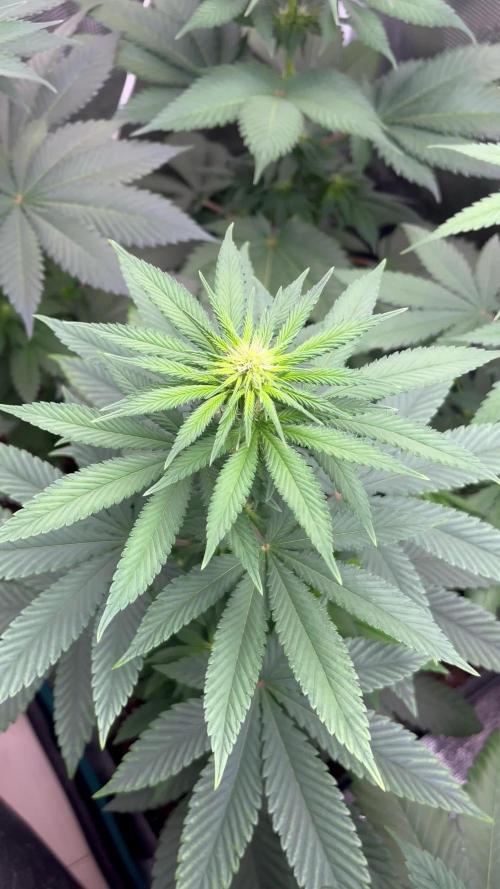The Grow Awards 2026 🏆 































Likes
Comments
Share


@BastiFarm
Follow
Octava semana de vegetación y esto luce así, hermosas y vigorosas las 2 Kukulkán, porfin pude solucionar la carencia que tenían, estoy regando con niveles de EC muy altos sobre los 2.0 pero si ellas lo asimilan bien entonces le damos no más, estoy regando con 5 ml de fertilizante radicular y 4 ml de algae plus y 3 ml de calmag.
Hoy preparé el suelo donde irán los clones con las micorrizas de elite 91 myco Jordan y tire unas semillas de happy clover, la mayoría de los clones ya están enraizados solo esperaré a que colonicen un poco más el vaso en donde están, estoy muy satisfecho con los resultados hasta ahora, ya que es primera vez que hago esquejes, veremos más adelante cómo evolucionan.
Aún no se cuantas semanas de vegetación les daré a las Kukulkán, todo depende de cómo crezcan y cuanto se demoren en el crecimiento.
EC: 2,3
PH: 6,4
Temperatura agua de riego: 21 grados
Temperatura indoor: 25 grados
Humedad relativa : 50%-85%
Likes
2
Share


@sunshinegroww
Follow
Nicely faded now and off to dry
Solid flowers and super sticky
Smells very gassy so far
Very uniform plant and super easy to grow
Will defo try one more time
Likes
6
Share


@Lordviper28
Follow
These lady's have been weird but have been growing great I got two them with Topps showing orange furs and are frosty as hell and smelling lovely this thebstart of the 5th week of flower
Likes
47
Share


@FreddyGrows
Follow
this was an amazing grow!!
Some things ive come to notice were.
*1* no more seeds directly in the big pot.
NEXT TIME ILL GROWN THEM IN A SMALL CONTAINER BEFORE TRANSFERRING THEM TO MAMA POT.
*2* i raised these babys with minimum of additives. Every 2 feedings.
NEXT TIME IN FLOWERING IMMA GIVE ADDITIVES EVERY TIME WATERING.
* the big pot needs a bit more water then 10L every watering.
SWITCH IT UP TO AN 15L of water instead of 10L
I am a very happy grower with my grow room havin very steady temperatures so these are no problems over here.
Next round i think i will ad a little bit of co2 to see if it makes any differences.
These plant made me happy from day 1.
They grew in a steady pace and gave everything they got.
The one big strong plant gave me almost 300gr in the end.😍😍😍
So now i have made some clones of him and we will see what they are going to do next round.
( follow my attack of the clones diary)
Very nice strain very very strong plants.
Defo a recommendation for anybody who loves a good taste and a stong high
I hope you guys find my diary usefull and i hope to see you guys in me next diaries
Greetings Freddy grow
Likes
5
Share


@MotherNaturesSon
Follow
this pheno was covered with resin, with plenty of snow covered sugar leaves, so this strain could definitely be good a source of sativa hash oil. medicinal potentials include migraines, depression, and fatigue
Likes
13
Share


@Bncgrower
Follow
Following the plan, the girls are beautiful and were already quite big during this stretching phase. I hope everything continues as it is now during this growth and weight gain phase. For the rest, just wait for time to pass. 🌱🌿✌️✌️
Likes
43
Share


@Regenwurm
Follow
Diese Woche nichts außergewöhnliches! Ich habe heute die Leistung auf 550 Watt erhöht. Klima passt perfekt, Entwicklung gesamt auch okay … die Ladies haben Durst und vertragen nicht mehr Dünger… die Indicas sind interessanterweise anfälliger für zu viel Dünger…. Für einen gleichen Start ist die Entwicklung sehr unterschiedlich! Immer wieder etwas Entlaubung da zu viele Blätter bei den Orange Sherbert…. Bis nächste Woche ✌️🏾
Likes
54
Share


@Ganjagrandaddy
Follow
Day 36 flowering: This lady is my superstar. her growthbhas been excellent and never slowed at any point. Her buds are solid and orangey when pressed. Size wise she is huge at 2ft from the pot top. 5 weeks left for her and i know she is going to be one of my personal bests. A beautiful Keeper strain so far.
Likes
35
Share


@hornato420
Follow
Week 12 looks girl #1 is coming to a end. I haven’t over fed or over watered and she’s starting to get yellow leaves. I feed her one more time at the end of this week. Starting week 13 I’m going to start to flush her.
Her smell has gotten more intense this week also. She smells like sweet tropical citrus. Also she looks to be filling in more and her buds are starting to get a little dense. She definitely exceeded my expectations. I couldn’t have predicted from veg she would be this size.
Girl#2 unfortunately never started flower and she’s going get 12-12 after I harvest girl #1. I’ll start another diary for girl #2 when that time comes. I knew she would be long winded but this is just extreme 😂.
I know you experienced growers know this story very well, but for a rookie like me 😆 I’m pulling my hair out and punching the air with frustration 👊🤬🤯😁. This for me is a learning experience and I love the duality of this grow. I’ll know better next time I run into this time of issue.
Thank you for viewing my diary. I will be looking to possibly harvesting this girl in the next few weeks or sooner,
Processing
Likes
13
Share


@MG2009
Follow
Sorry having issues uploading these pic went to week 4 somehow? But is actually week4 flowering, also brewing tea give my plants a little love.
05/09/2018
The boy's have been shaken twice a day last two days,dispersing copious amounts of pollen i mean clouds! It's forming layers in my tent, wish I could capture on video but its not picking it up😕 hoping it relates to strong offspring.
05/12/2018
Fourth week of flowering males are in overdrive! Making clouds of pollen
I am gonna harvest some for later use (it can last 6months or more of stored correctly.
I try and get video. Wish me luck👍🙏
05/14/2018
Harvesting pollen from the the boys. Video not greatest but you get the idea., Picture of #1 pollen and flower,will keep harvesting for a couple days, then cut off flowers and back to veg tent for more test.
06/18/2018
Coming up on sixth weeks after pollination, found two seeds popping out of the buds LAST week and I r germinated today!
Likes
13
Share


@Leanback
Follow
Doing not much… checking the vpd und water that’s it. Ladies looking good so far.
Likes
2
Share


@Double_AAs_Garden1
Follow
Had to move plant to a bigger PC I believe the dimensions where approx. 18"x 22"x 9"
Likes
12
Share


@mircostuffff
Follow
Sieht bis jetzt gut aus .Gustavo brauch noch ein wenig länger' denke er wird den meisten ertrag bringen lass gern eine Meinung dar ist mein 2ter versuch
Brauchte vllt tipps zum trocken etc
Likes
2
Share


@eldruida_lamota
Follow
Vamos familia, actualizamos la segunda semana de floración de estas Lemon Mandarin de FastBuds.
La temperatura que estuvo entre los 24-26 grados y humedad dentro de los rangos correctos.
En cuanto a las plantas las veo verde sano, estiraron bien y ensancharon bastante también.
Se nota que los nutrientes de la marca Agrobeta cubre todas las necesidades de cada ejemplar.
Las flores empezaron a formarse, por el momento todo correcto, os dejé también alguna novedad y un cambio en la sala, agradecer al equipo de Mars hydro por el nuevo TSW2000. (los últimos 5 años cultive solo con los leds de esta marca)los cuales probé, TS600, TS1000, TS3000, TSL2000.
Llevaba 10 años trabajando en sodio y fue un salto de gigantes cambiar a los Leds, jamás me arrepentiré de ese cambio.
- os dejo por aquí un CÓDIGO: Eldruida
Descuento para la tienda de MARS HYDRO.
https://www.mars-hydro.com
Hasta aquí todo, Buenos humos 💨💨💨
Likes
10
Share


@Minuteman_Organics
Follow
Loud hashy, pepper, sulfur, rotten fruit, lemon, and Skittles terps.
The landraces got nice structure, terps and yield but resin is lacking. I think that's normal. Gonna have to cross these a few times till I find something great that is worth it.
Likes
16
Share


@Tezza2
Follow
The purple lemonade auto is growing better its looking good the gorilla glue auto isnt showing any sign of preflower yet im starting to think it may be a photoperiod plant .The gorilla glue auto still isn't showing any sign of preflower yet i dont know what to do i don't want to go to a 12/12 because i dont want to stuff up my purple auto thats in flower





















